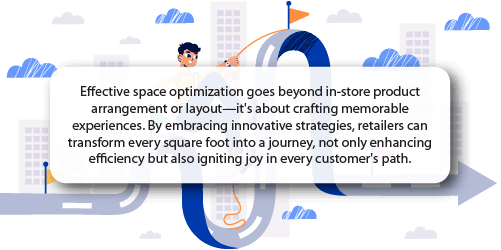Retail efficiency goes beyond sales metrics; it encompasses other crucial factors, including floor space optimization. This critical approach leverages innovative strategies to transform every inch of store space into a dynamic tool for enhancing customer experiences, boosting sales, and elevating store performance. And, thriving today means retailers must understand such spatial optimization techniques.

Understanding the 'Why' behind effective floor space optimization reveals its pivotal role in long-term retail success. While strategic retail layout design allows retailers to expose shoppers to more products, it also guides consumer behavior, encouraging exploration and additional purchases. Considering every square foot in-store counts, optimizing retail space is essential for capturing customer interest, enhancing their shopping journey, and securing a competitive edge.
Delving into 'How' retailers can achieve this optimization, the key lies in innovative store space management strategies that blend technology, consumer psychology, and design principles. From leveraging data analytics for layout decisions to employing dynamic shelving for adaptability, these approaches ensure a store layout maximizes and balances functionality with aesthetic appeal.

Dynamic shelving and modular layouts
The ability to quickly adapt retail layout designs and store displays to changing trends, seasons, and consumer preferences is crucial for maintaining customer interest and maximizing sales.
That's where dynamic shelving and modular layouts play a significant role.
Both offer retailers the flexibility and adaptability needed to achieve these goals. These innovative systems allow for rapid reconfiguration and better store space management, ensuring a retail environment remains fresh, engaging, and optimized for performance.
The flexibility of dynamic shelving for retail adaptability
Dynamic shelving systems allow retailers to change their store layout with minimal effort. This flexibility is essential for accommodating new product lines, seasonal merchandise, or varying stock levels.
A good example is The Container Store, which uses dynamic shelving throughout its locations, enabling quick adjustments to shelving heights and configurations to showcase different product categories effectively. This adaptability enhances product visibility and improves the shopping experience by ensuring products are easily accessible and well-organized.
Adaptability of modular layouts for better store design
Modular store layouts take flexibility further by allowing retailers to reconfigure or update entire sections. These retail layout designs typically involve rearranging movable fixtures, walls, and display units to create new spaces or themes within the store.
Nike's flagship stores are a prime example of modular design in action. They feature interchangeable display components and modular fixtures that they reposition to highlight specific product lines or marketing campaigns. It's an effective strategy for drawing attention to new or featured items.
Responding to trends and consumer preferences
The real power of dynamic shelving and modular layouts lies in their ability to respond to changing trends and consumer preferences.
Retailers can swiftly adapt their store environments to reflect current fashions, seasonal changes, or emerging consumer demands.
For example, H&M regularly updates its retail layout design to keep pace with rapidly changing fashion trends. By incorporating modular fixtures and dynamic display systems, H&M ensures that its latest collections are prominently featured, encouraging customer exploration and purchase.
Dynamic shelving and modular layouts offer retailers a competitive edge by enabling them to maintain a retail environment that aligns with the latest trends and customer needs.
These systems provide retailers the flexibility and adaptability required to respond to the market, ensuring that stores remain fresh, relevant, and engaging. As the retail landscape evolves, adopting such dynamic and modular design principles will be key to creating spaces that attract and retain customers.

Integrate technology or become redundant
Shoppers expect more from their in-store experience, so retailers must leverage technology or face the reality of losing to their competition.
With the right technology, retailers can enhance their floor planning efforts, optimize inventory management, and improve customer experiences.
Two examples of such technology are Artificial Intelligence (AI) and the Internet of Things (IoT). Both are at the forefront of this transformation, offering solutions that streamline operations and provide insights into customer behavior and preferences.
Make smart inventory management decisions with AI and IoT
AI-powered inventory systems
AI technologies enable sophisticated inventory management by predicting stock levels, identifying trends, and automating replenishment orders.
For example, Walmart uses AI in its inventory management systems to analyze sales data and predict stock needs, significantly reducing overstock and understock situations. Other examples include Walgreens and ASOS.
IoT for real-time inventory tracking and a better customer experience
IoT devices such as RFID tags offer real-time inventory tracking, providing accurate stock levels and location information.
Zara employs RFID technology to monitor item movements from warehouse to store floor, ensuring optimal stock levels and quick restocking of popular items, thereby enhancing the shopping experience. Amazon also employs RFID with its Just Walk Out technology.
Customer flow analytics via technology
Heatmaps for customer movement
Advanced analytics tools use IoT sensors to generate heat maps, visualizing customer movement throughout the store. This data helps retailers understand high-traffic areas, enabling them to optimize product placement and their retail layout design.
DotActiv software has heatmapping built into its floor planning capability and allows retailers to understand the position of their best-sellers in-store.
AI for traffic analysis
AI algorithms analyze video footage to gain insights into customer paths and dwell times. This information is crucial for designing store layouts that facilitate smooth customer journeys and reduce bottlenecks.
British supermarket chain Tesco has experimented with AI-driven customer flow analytics to rearrange store layouts, enhancing the shopping environment and increasing sales in key product areas.
Personalized shopping experiences through technology
Virtual store walkthroughs
Virtual reality (VR) allows customers to navigate digital replicas of physical stores from the comfort of their homes. IKEA's VR kitchen experience lets customers explore different kitchen setups, interact with products, and make informed decisions, bridging the gap between online and in-store shopping.
Personalized recommendations
AI and machine learning algorithms analyze customer data to offer personalized product recommendations. Sephora's mobile app uses AI to provide customized makeup recommendations, allowing customers to try products virtually, leading to more confident in-store purchases.
Integrating AI and IoT technologies into retail floor planning and store space management is reshaping the industry, offering unprecedented efficiency, insight, and customer engagement.
By managing inventory, analyzing customer flow, and personalizing the shopping experience, retailers can optimize their operations and enhance their competitiveness in the rapidly evolving retail landscape.

Enhance the shopping experience with a customer-centric design
A customer-centric approach to store design is not just beneficial - it's essential. This strategy focuses on creating a shopping environment that prioritizes the needs and desires of the customer, aiming to provide an engaging, satisfying, and memorable experience.
Retailers who craft their stores with the customer experience in mind foster a more engaging shopping environment and set the stage for increased sales.
But how can retailers achieve this?
Enhance exploration with thematic zones
Creating thematic zones within a store organizes products around specific themes or stories, making the shopping experience more intuitive and engaging.
For example, Nike's House of Innovation provides a unique experience, connecting shoppers to the community of sport. This setup simplifies the shopping process and immerses customers in a curated experience, encouraging exploration and engagement.
Boost engagement with interactive elements
Incorporating interactive elements like digital kiosks, augmented reality (AR), and hands-on product demos engages customers more deeply with products and the brand story.
Sephora's Virtual Artist app, available via in-store kiosks, uses AR to let customers try makeup virtually. This blend of digital and physical interaction enhances the customer's shopping experience, aiding in informed purchase decisions and increasing overall satisfaction and sales.
The success of customer-centric floor planning
Focusing on the customer experience through strategic floor planning significantly impacts engagement and sales. When shoppers not only find it easy to navigate through a store navigable but also exciting, their engagement increases, leading to staying for longer and making more purchases.
Apple's retail stores exemplify the power of customer-centric design, featuring an open retail layout design, interactive product zones, and the Genius Bar for personalized service. This approach has propelled Apple stores to be among the most successful retail spaces worldwide when considering sales per square foot. In 2017, CNBC reported that Apple does $5546 in sales per square foot.
The transition towards customer-centric retail spaces is not a trend but a shift in how retailers connect with their customers.
By prioritizing the shopping experience through thoughtful design and interactive technology, retailers can captivate their audience, encouraging immediate sales and fostering long-term loyalty.

Incorporate sustainability and be agile to ensure retail longevity
In the face of growing environmental concerns and shifting consumer expectations, the retail sector is increasingly embracing practices that are not only sustainable but also agile.
This strategic shift reflects a dual commitment: to environmental stewardship and swift adaptation in response to market dynamics. It’s a recognition that sustainability and agility, when integrated, can propel retail environments toward more resilient and adaptable futures.
Embracing sustainability in retail design
Eco-friendly materials and waste reduction
With the increased consumer interest, more and more modern retailers have turned to using sustainable materials in their store designs, such as bamboo, reclaimed wood, and recycled metal. While environmentally friendly, such materials add aesthetic value to the store.
For example, Starbucks has committed to designing and building all new, company-operated stores globally with 100% renewable energy. They use responsibly sourced materials and aim to achieve Leadership in Energy and Environmental Design (LEED) certification for these stores, significantly reducing their environmental footprint.
Energy efficiency and sustainable practices
Incorporating energy-efficient lighting and HVAC systems, solar panels, and green roofs can drastically reduce a store's energy consumption.
Patagonia, known for its commitment to the environment, incorporates solar panels in many of its stores and uses recycled materials for construction and fixtures, demonstrating how to integrate sustainability into every facet of retail design.
Building agile store environments
Modular and flexible designs
As mentioned earlier in this article, agility in retail design involves creating spaces that retailers can reconfigure easily for different purposes or layouts. It's worth reiterating.
This flexibility allows retailers to respond quickly to consumer behavior changes or market trends. Nike’s concept store, Nike Live, is an example of agility in practice - catering to the local tastes of its location, allowing the company to make loyal members happy while also giving not-yet-members a good reason to join.
Technology integration for adaptability
Using digital displays and interactive technology enables retailers to change messaging and promotions without physical alterations to the store layout.
For example, Adidas has experimented with digital walls that display different content based on current marketing campaigns, making it easy to update the store environment without extensive renovations.
The true innovation lies in the symbiosis between agility and sustainability. Agile design principles support sustainability by facilitating the reuse of materials and enabling stores to adapt to sustainable technologies without extensive rebuilds. This interconnected approach not only minimizes waste and conserves resources but also ensures that retail spaces can quickly pivot in response to evolving sustainability standards and consumer preferences.
The retail landscape is undergoing a significant transformation, with sustainability and agility at its core. By adopting these practices, retailers can ensure their spaces are more sustainable and efficient, and adaptable to the ever-changing retail landscape.
Conclusion
By mastering floor space optimization and innovative retail layout design strategies, retailers can unlock the key to maximizing efficiency and better store space management. Embrace these strategies with DotActiv Enterprise and transform your retail space.
Begin your journey towards retail excellence today by signing up for a free 14-day trial of DotActiv Enterprise, and witness the transformation firsthand.


